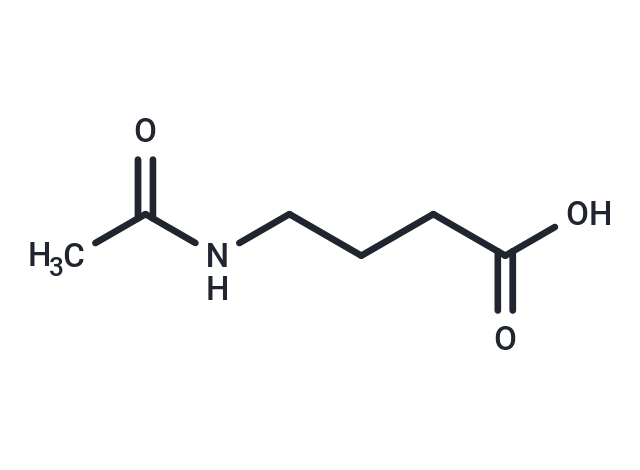Shopping Cart
Remove All Your shopping cart is currently empty
Your shopping cart is currently empty
4-Acetamidobutanoic acid (4-ACETAMIDOBUTYRIC ACID) can be found in blood, feces, and urine, as well as in human prostate tissue. 4-Acetamidobutanoic acid exists in all eukaryotes, ranging from yeast to humans. 4-Acetamidobutanoic acid is a GABA derivative, a product of the urea cycle and the metabolism of amino groups, and the product of NAD-linked aldehyde dehydrogenase (EC 1.2.1.3) (KEGG).

| Pack Size | Price | USA Warehouse | Global Warehouse | Quantity |
|---|---|---|---|---|
| 100 mg | $31 | In Stock | In Stock | |
| 500 mg | $52 | In Stock | In Stock | |
| 1 g | $73 | In Stock | In Stock | |
| 1 mL x 10 mM (in DMSO) | $39 | In Stock | In Stock |
| Description | 4-Acetamidobutanoic acid (4-ACETAMIDOBUTYRIC ACID) can be found in blood, feces, and urine, as well as in human prostate tissue. 4-Acetamidobutanoic acid exists in all eukaryotes, ranging from yeast to humans. 4-Acetamidobutanoic acid is a GABA derivative, a product of the urea cycle and the metabolism of amino groups, and the product of NAD-linked aldehyde dehydrogenase (EC 1.2.1.3) (KEGG). |
| Synonyms | N-acetyl GABA, 4-ACETAMIDOBUTYRIC ACID |
| Molecular Weight | 145.16 |
| Formula | C6H11NO3 |
| Cas No. | 3025-96-5 |
| Smiles | CC(=O)NCCCC(O)=O |
| Relative Density. | 1.133 g/cm3 |
| Color | White |
| Appearance | Solid |
| Storage | Powder: -20°C for 3 years | In solvent: -80°C for 1 year | Shipping with blue ice/Shipping at ambient temperature. | |||||||||||||||||||||||||||||||||||
| Solubility Information | DMSO: 50 mg/mL (344.45 mM), Sonication is recommended. | |||||||||||||||||||||||||||||||||||
Solution Preparation Table | ||||||||||||||||||||||||||||||||||||
DMSO
| ||||||||||||||||||||||||||||||||||||
| Size | Quantity | Unit Price | Amount | Operation |
|---|

Copyright © 2015-2025 TargetMol Chemicals Inc. All Rights Reserved.